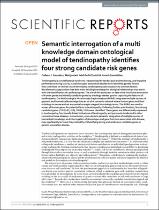| dc.contributor.author | Saunders, Colleen J. | |
| dc.contributor.author | Dashti, Mahjoubeh Jalali Sefid | |
| dc.contributor.author | Gamieldien, Junaid | |
| dc.date.accessioned | 2023-03-07T08:02:22Z | |
| dc.date.available | 2023-03-07T08:02:22Z | |
| dc.date.issued | 2016 | |
| dc.identifier.citation | Saunders, C. J. et al. (2016). Semantic interrogation of a multi knowledge domain ontological model of tendinopathy identifies four strong candidate risk genes. Scientific Reports, 6, 19820. https://doi.org/10.1038/srep19820 | en_US |
| dc.identifier.issn | 2045-2322 | |
| dc.identifier.uri | https://doi.org/10.1038/srep19820 | |
| dc.identifier.uri | http://hdl.handle.net/10566/8541 | |
| dc.description.abstract | Tendinopathy is a multifactorial syndrome characterised by tendon pain and thickening, and impaired
performance during activity. Candidate gene association studies have identified genetic factors
that contribute to intrinsic risk of developing tendinopathy upon exposure to extrinsic factors.
Bioinformatics approaches that data-mine existing knowledge for biological relationships may assist
with the identification of candidate genes. The aim of this study was to data-mine functional annotation
of human genes and identify candidate genes by ontology-seeded queries capturing the features of
tendinopathy. Our BioOntological Relationship Graph database (BORG) integrates multiple sources of
genomic and biomedical knowledge into an on-disk semantic network where human genes and their
orthologs in mouse and rat are central concepts mapped to ontology terms. The BORG was used to
screen all human genes for potential links to tendinopathy. Following further prioritisation, four strong
candidate genes (COL11A2, ELN, ITGB3, LOX) were identified. These genes are differentially expressed
in tendinopathy, functionally linked to features of tendinopathy and previously implicated in other
connective tissue diseases. In conclusion, cross-domain semantic integration of multiple sources of
biomedical knowledge, and interrogation of phenotypes and gene functions associated with disease,
may significantly increase the probability of identifying strong and unobvious candidate genes in
genetic association studies. | en_US |
| dc.language.iso | en | en_US |
| dc.publisher | Nature Research | en_US |
| dc.subject | Data mining | en_US |
| dc.subject | Gene ontology | en_US |
| dc.subject | Tendons | en_US |
| dc.subject | Bioinformatics | en_US |
| dc.title | Semantic interrogation of a multi knowledge domain ontological model of tendinopathy identifies four strong candidate risk genes | en_US |
| dc.type | Article | en_US |

